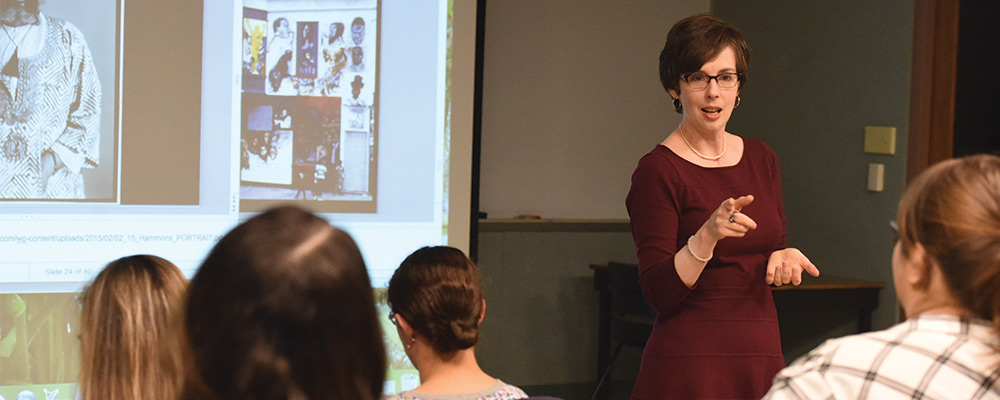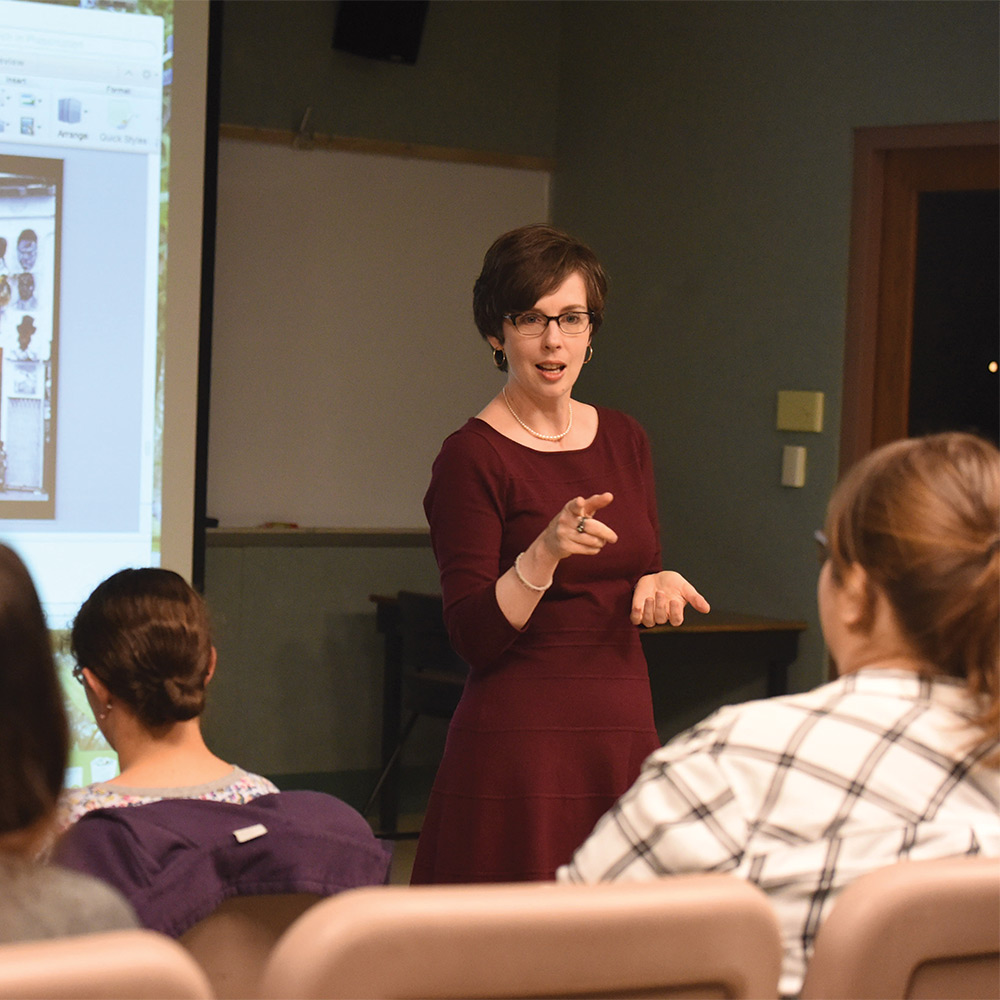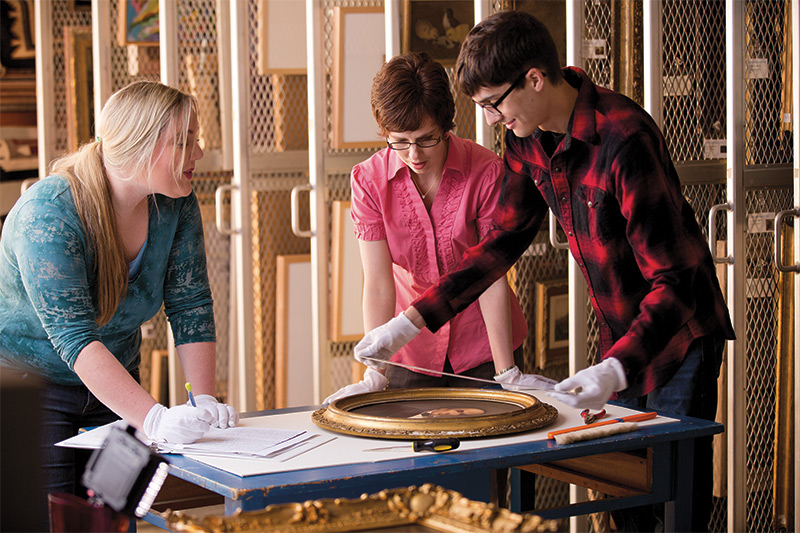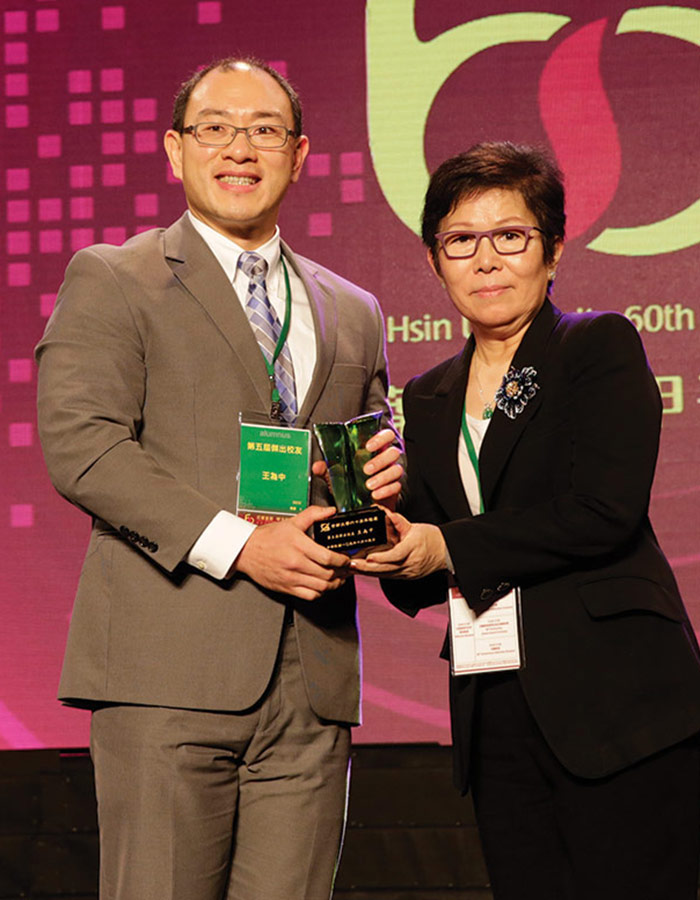Surprisingly, all these counter-intuitive lines apply to Juniata's own Jennifer Streb '93, associate professor of art history, and her career story can almost serve as a template/testimonial for the glories of a liberal arts education.
Before arriving at the College, however, Jen lived a life of studiousness, sports, and small snippets of celebrity sprinkled throughout her childhood. Her parents, Tom and Patty Streb, raised two girls in a nice house in Altoona. Her dad, known professionally as Tom Casey, started his career as a radio sports broadcaster and eventually became an iconic television personality by anchoring the Altoona-based WTAJ-TV weathercast for more than two decades.
Although everybody in central Pennsylvania knew Casey the Weatherman, few people in town outside his circle of friends know the rest of his life was listed under the name Tom Streb. That allowed the family some peace from possible prank calls, weather predictions, and requests to gain an entrée into television. "When my sister and I were little we used to think it was weird that strangers would come up to our table when we were out to dinner and ask my dad what the weather was going to be," she says. "My favorite answer was ‘Union rules prevent me from telling,' which seemed to work well."
So, Jen was able to fly a bit under the radar at Altoona Area High School, taking college prep courses. One day, a counselor told her to take one "fun" course every year, so she began taking art courses: "Drawing," "Watercolor Painting," and "Survey of Art History."
"I like art, but I wasn't very good at it," she admits. But she excelled at art history, right? Um, well, no. "It was boring. The lights were out, it was 7th period and the teacher stood at the back of the room and droned on like that scene in Ferris Bueller," she laughs.
Armed with that perception, she entered Juniata as a finance POE. She had worked as a bank teller throughout high school, which to her was a logical segue to the work of finance. "I was doing fine until I took Managerial Accounting with Ron Cherry '53," she says. "He was tough and I think I spent the semester crying about how poorly I was doing."
Although her vision of a Sheryl Steinberg-like business career was beginning to circle the drain, Jen also kept taking art courses. One course had a pre-requisite that she had to take Survey of Western Art and she met with art historian Karen Rosell to see if she would waive the pre-requisite. The answer was, "No."
Instead of a dry, academic dronefest, the course, taught by Rosell, energized Streb in a way that left her idea of a career in finance a bit less sure. "We spent hours talking about the art and you had to know history, religion, and other things," she explains. "I tell all my students what makes art history great is that it's incredibly interdisciplinary."
"Art isn't created in a vacuum; it's always been part of the larger society," she adds. "I've found that fascinating."
When Jen graduated in 1993 she saw her career path much more clearly. She hesitated to commit to a career in art because she bought into the perception that art careers do not pay well. After seeing Rosell in action for three years and talking with other professors, she realized she could pursue a professorial career. "My mother had these two antique school desks and my sister and I would play classroom all summer," she says. "I was always the teacher."
Foreshadowing aside, Jen decided to go to graduate school at Penn State. During her studies she found a niche in American art and began to look for an artist to research. In the summer after her Juniata graduation, Jen had worked at events at the Southern Alleghenies Museum of Art, supervised by then-curator Michael Tomor and the museum's then-director Michael Strueber (also a former Juniata Trustee). She mentioned she was looking for a research project and both men suggested a Pittsburgh artist named Henry Koerner.
Koerner was an Austrian immigrant who fled Europe in the late 1930s and ended up teaching art at what is now Carlow College. Koerner, who painted many covers for Time magazine, also painted personal pieces that combined the urban grit of Pittsburgh with scenes of magical realism, such as dancers floating above the steel bridges.
She was put in touch with Koerner's widow and Jen began to research the life and work of the somewhat unknown Pittsburgh artist. "I like digging out these threads and seeing where things take you," she says. "There is something about finding a piece of information that is very exciting." Such dogged determination held her in good stead when she decided to get her doctorate at Penn State, but she needed a fresh topic to research. Asked by her adviser what she really wanted to suss out, the answer came back: art of the 1930s and feminism. Originally her idea was to research an artist and administrator involved with the Works Progress Administration's Federal Art Project Arts project. She started combing through art catalogs of exhibitions featuring women. She came across a catalog for "Seven Women of the Depression Decade," a 1976 exhibit at Vassar College. In the catalog was a short blurb about a satirical series of prints with a feminist tilt called "Feminanities."
"Art isn't created in a vacuum; it's always been part of the larger society."Jennifer Streb, Associate Professor of Art
The artist was Minna Citron, born in 1896. Citron started her career as a representational artist, creating satirical prints of everyday life. "Feminanities," skewered the pretensions of middle-class women and made clear her critique of a beauty-based society. After World War II, Citron's art evolved into abstraction.
Streb's investigation eventually led her to the Susan Teller Gallery, a New York City gallery specializing in American Art from the 1920s to 1950. She sent a letter to the owner and Susan Teller invited Jen to visit. "She gave me contact information for Minna's sons, Casper and Thomas," she says. Jen then sent letters to both men and received a reply from Thomas. He had artworks from his mother but didn't have much documentation from her career as an artist—crucial for historians. Another letter, to Minna's son Casper, went unanswered. Jen continued on with her research.
Fast-forward about two years and Jen's husband, Kevin Moist, a communications professor at Penn State Altoona, walked in to their living room and announced, "Minna's granddaughter is on the phone."
It was indeed Christiane Citron calling. It seems that Jen's original letter of inquiry had arrived about the time that her father, Casper, passed away. Her letter remained on the top of his desk until Christiane came to put his estate in order.
"She had spent her whole life trying to get recognition for her grandmother's career," Jen recalls. "It was exciting for her and exciting for me that she found my letter."
Jen traveled to Christiane's Denver, Colo., home and found a treasure trove of material—scrapbooks, exhibit catalogs, artworks—which allowed her to finish her dissertation on Citron and earn her doctorate in 2004. In 2005, she was hired by her alma mater as an art history professor. In the same way she tells her students that art history is the ultimate definition of interdisciplinary learning, working at Juniata has worked some multidiscipline magic on Jen herself.
As curator of the Juniata College Museum of Art, she's taught students everything from framing to painting walls. She collaborated with chemist Richard Hark to use lasers, X-rays, and CAT scans to analyze artwork. She even team-teaches "Chemistry of Art" with Hark. Not bad for someone who never took chemistry in college.
"I'm not a painter or a sketcher," she says, "I like finding my creativity in the museum and the classroom."











